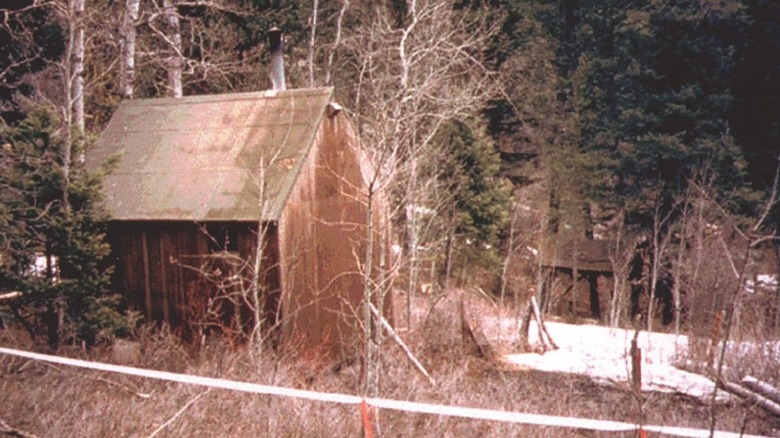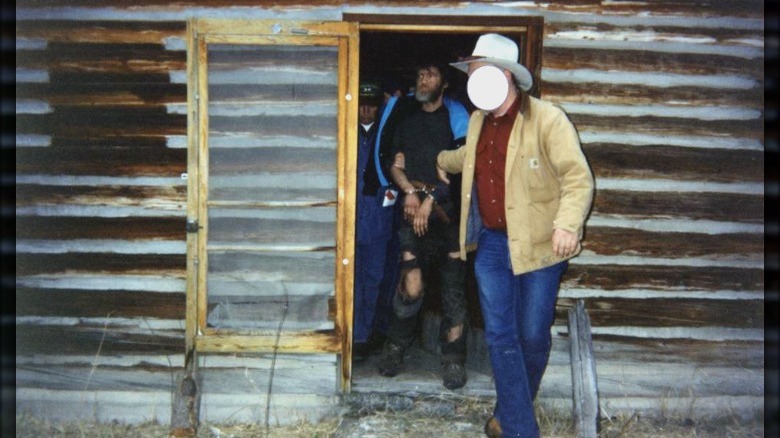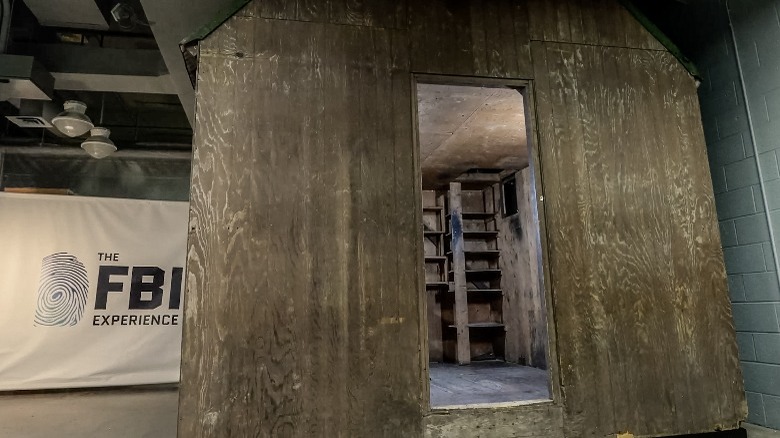What Happened To The Unabomber's Cabin?
Nestled in the woods near Lincoln, Montana, stood a small structure that housed the subject of one of the FBI's most worked manhunts in their history. Theodore "Ted" Kaczynski, more commonly known as "The Unabomber," constructed the cabin in 1971. From the time he moved into it until his arrest by federal authorities in 1996, Kaczynski worked toward being self-sufficient and living off the grid.
For over two decades, he would subsist on the wild game he captured. A diet of porcupines, rabbits, and squirrels were his mainstay, per The Washington Post, cooked on an open outdoor fire. Inside, there were shelves of books about survival, nutrition, and world languages, according to the Independent Record. From the outside looking in, the cabin's inhabitant was a solitary man who removed himself from society and survived on what the land provided. But the reality was much more sinister. Between 1978 and 1995, Kaczynski was busying himself with constructing explosive devices and mailing them to targets, primarily universities and airlines. The victims in Kaczynski's 16 bombings totaled more than two dozen. Most sustained injuries, but three people died in separate mail bombings.
The cabin served as not only a refuge for a man who was through living in modern society but also as the headquarters of a one-man war against society. Those making the trek near the Scapegoat Wilderness area in west-central Montana to see Kaczynski's former property will find remnants of the lean-to he used for storage but little else to indicate that he lived there for 25 years. The cabin was moved to a different location in 2006 and can be viewed by the public today.
The Washington, D.C. Newseum housed the cabin for years
In 2006, a court ordered that all of Kaczynski's possessions be auctioned, with the proceeds being divided among his many victims. According to The New York Times, the auction included the cabin that Kaczynski constructed. By the time the auction was over, the sale yielded over $200,000 (via Atlas Obscura). The cabin was purchased by the Newseum and put on public display. This Washington, D.C.-based museum carefully reassembled the dwelling inside its 643,000-square-foot building, adding an anchor to its already impressive collection of artifacts.
NBC Montana reported that the 10x12 cabin was about as rustic as you could get. Kaczynski lived without the modern marvels of running water or electricity. There was a "cutaway spot" in the floor for when nature called. A wood stove heated the one-room structure, built with a gabled roof high enough to have a loft space.
In a video shown at the Newseum, a former FBI agent described what the cabin was like when it was raided and searched. He described that it smelled terrible. Photos taken by the FBI (and shared via the Independent Record) showed books haphazardly shoved into shelves built along its walls. Various grocery items, survival gear, debris, and bomb-making supplies were strewn about the cabin. A solitary cot and bedding were along one wall, where Maeve Scott, the director of collections at the Newseum, said the oils from Kaczynski's body formed an outline on the wall he laid against.
You can now visit the Unabomber cabin at FBI Headquarters
Sadly, the Newseum closed its doors at the end of 2019. Smithsonian Magazine reports that financial difficulties made it impossible to remain open, prompting its sale to John Hopkins University for nearly $400M (via WTOP News). During its 11 years of operation, the Newseum hosted more than 10 million visitors. The closure of this attraction didn't mean that you could no longer see Kaczynski's former cabin. In 2020, the FBI took possession of the cabin and installed it at their Washington, D.C. headquarters (per FBI). A time-lapse video shows the meticulous process of putting the structure back together, piece by piece.
The Unabomber's cabin is on display as part of The FBI Experience. This self-guided tour takes visitors through many of the bureau's most notorious cases, emphasizing the hard work and determination each agent puts into capturing the bad guys. The FBI Experience is open to the public, though getting into the bureau's headquarters requires jumping through a couple of hoops. You must schedule your visit in advance, between four weeks and five months before your arrival. Additionally, you must schedule the tour through your congressperson via email. Upon approval by the bureau, you'll receive emails confirming the date and time of your visit and security clearance.
On June 10, 2023, Kaczynski died by suicide in his prison cell at Federal Medical Center in Butner, North Carolina where he was being treated for cancer that had progressed to the end stages. He was 81.


